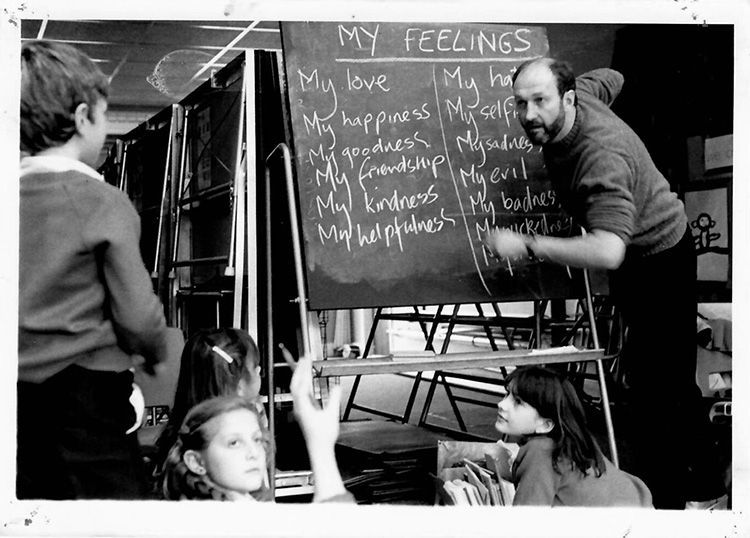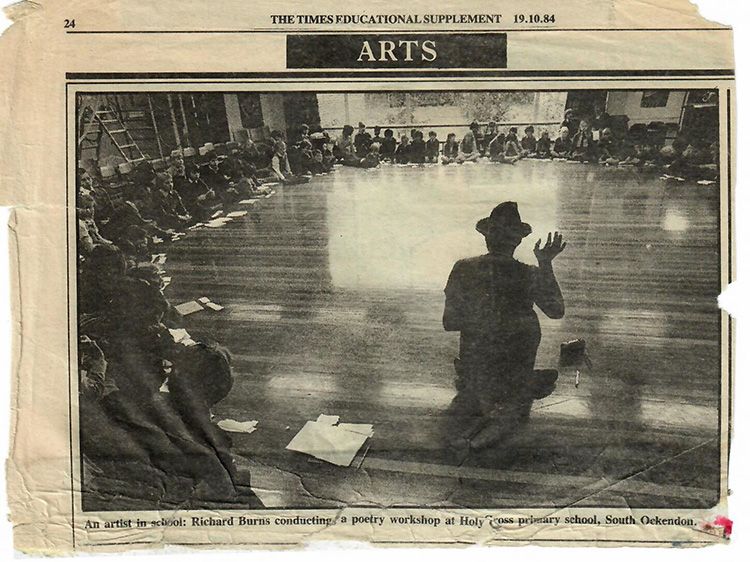
Mick Gowar (UK)
Richard and ‘the art of
unthinking’
Elsewhere, I’ve written about the importance of the concept of community in so much of Richard’s work, and in particular his foundation of the international Cambridge Poetry Festival (Jope, Derrick and Byfield 2011:387-396). Richard has also at different times described community as a core component of his ‘Universal Poetics’ project (Jope, Derrick and Byfield 2011:395) and it later informed his ‘First Imaginationist Manifesto' (Berengarten 2021:n.pag.).
It was in that manifesto that Richard declared – despite COVID, which at the time seemed to overshadow everything – his belief that poetry brought ‘joy… in the thisness, the hereness, the nowness of the this-here-now’, and in no aspect of Richard’s work has this belief in creating joy in the here and now been more consistently apparent than in another aspect of his commitment to building communities of writers and readers: his work as a visiting poet and creative writing teacher in schools.
In 2006, in an article in the journal Writing In Education [i] (Berengarten 2006), Richard summarised how he sought to imaginatively engage and enthuse as many as 150-200 children to write their own poetry – specifically haikus – through a creative process he described as ‘Unthinking’. This term could easily be misconstrued as suggesting writing ‘from within, without aesthetic rules, or knowledge of poetic form or conventions’ (Harris: 2007). However, what Richard meant by ‘unthinking’ was making an imaginative engagement with what might be only a fleeting experience in a way which is qualitatively different from: ‘so much thinking…that interferes with all other processes. Thinking that has got so dense and insistent it’s almost impossible to hear or see anything else that’s actually happening’ (Berengarten 2006:23). In the same article he presents ‘unthinking’ as cognate with ‘similar verbs, like unfasten, unwrap, undo … merely not-thinking or the absence-of-thinking … but the opening, loosening, and even dissolving of thinking.’ (Berengarten 2006: 20).
What Richard was hoping for, and from, the pupils was
lightness, spontaneity, speed, expansiveness and exploration; dynamic interplay between perception and language…to start off with any image that catches their attention. Their aim, I say, is to catch whatever image catches them.
It’s not unlike the sort of thinking which Ted Hughes described in the key chapter, ‘Learning to Think’ in Poetry In The Making, his justly famous anthology based on broadcasts for schools:
There is the inner life, which is the world of final reality the world of memory, emotion, imagination, intelligence and natural common sense….There is also the thinking process by which we break into that inner life and capture answers….That process of raid, or persuasion, or ambush, or dogged hunting, or surrender, is the kind of thinking we have to learn and if we do not somehow learn it, then our minds lie in us like the fish in the pond of a man who cannot fish. (Hughes 1967: 57-58)
I think it’s a great pity that, unlike Ted Hughes, Richard has never had the time, or perhaps the inclination, to devote an entire book for pupils and teachers on his own experiences, discoveries and innovations in the teaching of creative writing and the means by which he was able to facilitate the ‘dynamic interplay between perception and language’ for so many fortunate children. Especially now, when instrumentalism has all but destroyed the community of eager and excited young writers and readers which Richard envisaged. What is so woefully missing from contemporary British classrooms – and I dare say classrooms all around the world – is what Richard used to offer and which Margaret Satchwell a teacher with whom Richard worked summarised as:
the kind of risk that is essentially missing from today’s planning machine, transcripts of lessons and set objectives; the kind of risk or creative frisson which keeps us all awake, interested, intrigued and challenged. (Jope, Derrick and Byfield 2011:405).
Notes
[i] The Journal of the National Association of Writers in Education (NAWE).
References
Berengarten, Richard (2006) [writing as Richard Burns] ‘The Art of Unthinking’, Writing In Education 39, Summer 2006, pp. 20-23.
Berengarten, Richard (2022) ‘On The Spirit of Poetry in a Time of Plague: The First Imaginationist Manifesto’. The Fortnightly Review, July 2022.
Harris, Mike (2007) ‘The Art of Thinking’, Writing In Education 41, Spring 2007, pp. 45-48.
Hughes, Ted (1967) Poetry in the Making. London: Faber & Faber.
Jope, Norman; Derrick, Paul Scott; and Byfield, Catherine E. (2011). The Salt Companion to Richard Berengarten. Cambridge: Salt Publishing.
Back to introduction here.
Next contribution here.


